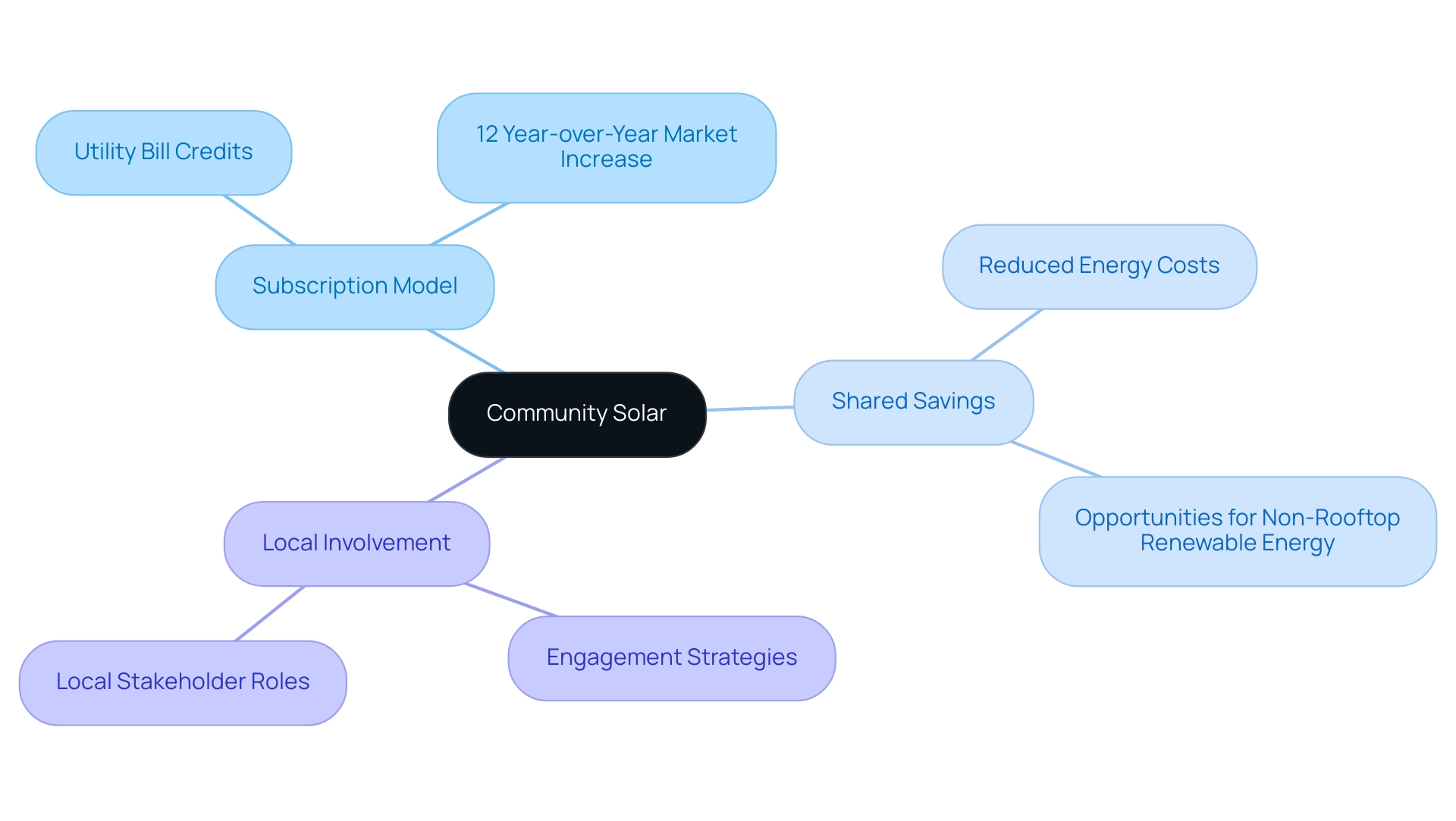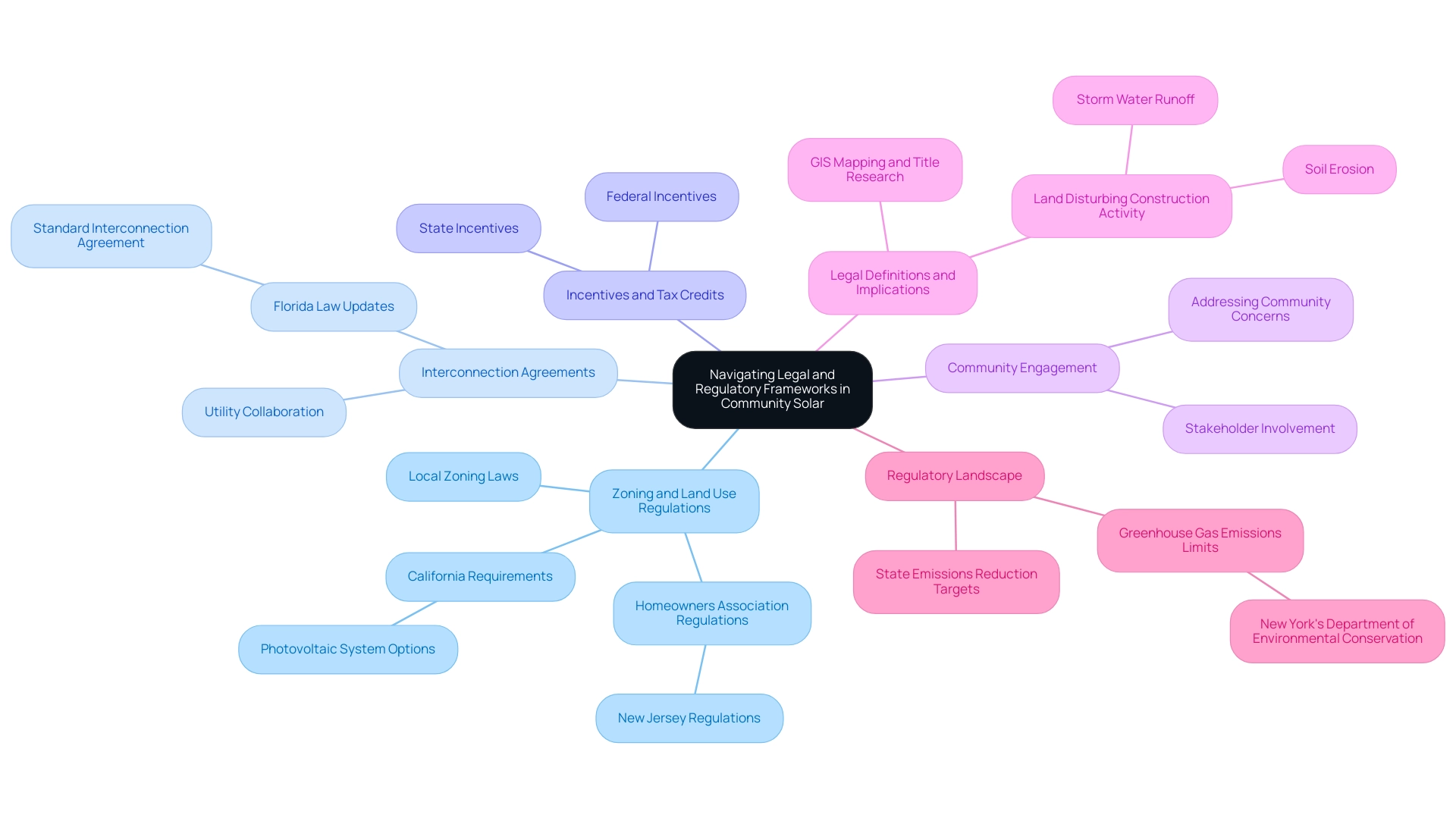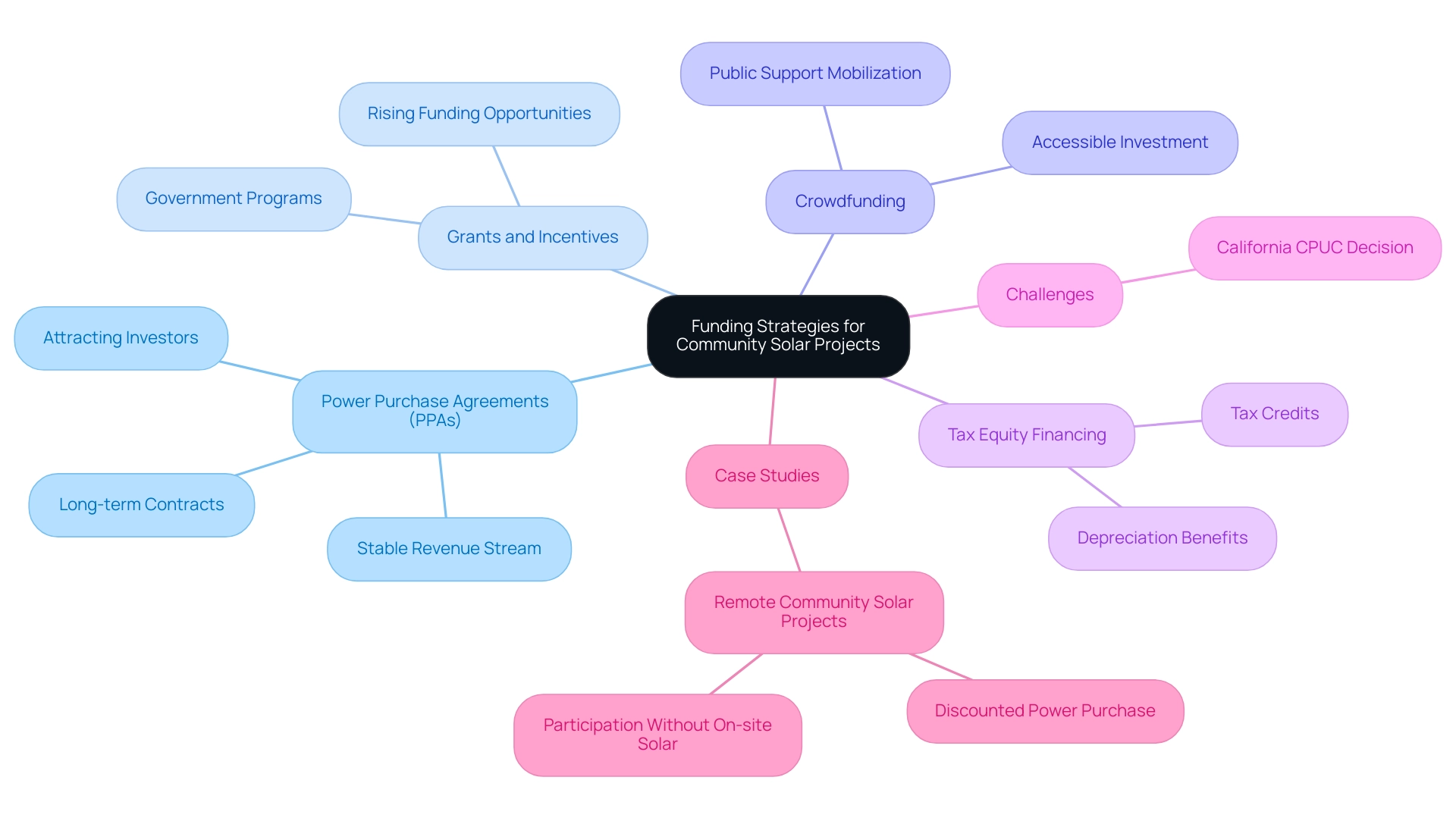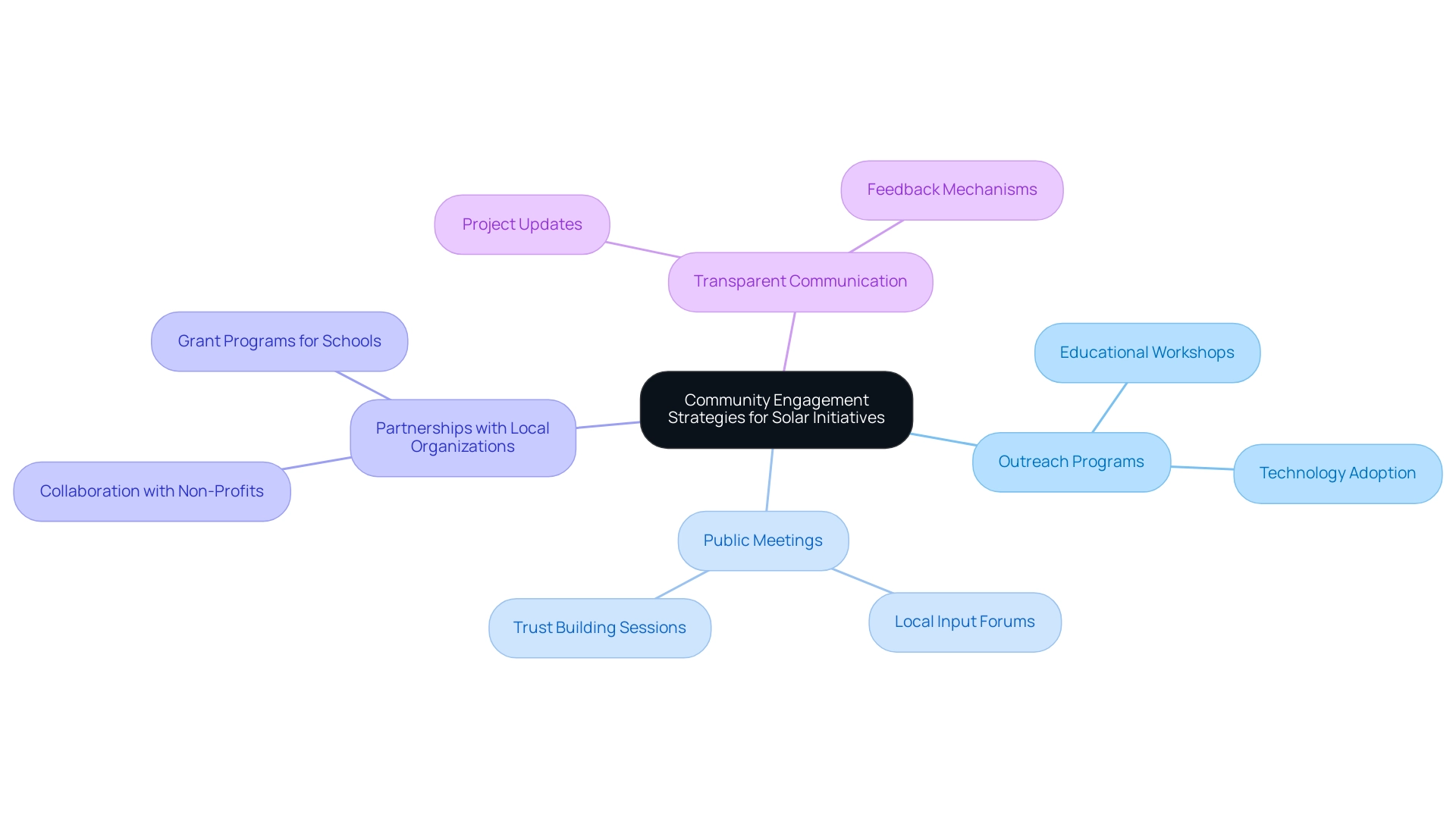Overview
Community solar project structuring involves a systematic approach that includes feasibility studies, stakeholder engagement, business model development, and navigating legal frameworks to ensure successful implementation. The article emphasizes the importance of these steps by illustrating how they collectively enhance project viability, foster community involvement, and align with economic, environmental, and social goals, ultimately promoting sustainable energy solutions.
Introduction
In a world increasingly focused on sustainability, community solar emerges as a beacon of hope, offering a collaborative approach to harnessing renewable energy. This innovative model allows groups of individuals to share in the benefits of solar power, making it accessible to those who might otherwise be left in the dark.
By exploring key concepts such as:
- Subscription models
- Shared savings
- Community engagement
the article delves into the transformative potential of community solar projects. With the U.S. solar market experiencing significant growth and an increasing emphasis on economic and environmental advantages, understanding the intricacies of structuring successful community solar initiatives becomes essential.
As communities rally around these projects, the implications for energy equity and local economies promise to reshape the future of renewable energy.
Understanding Community Solar: Key Concepts and Definitions
Community solar project structuring represents a transformative approach to renewable resources, enabling multiple members of a community to benefit from a shared renewable facility. This model revolves around several key concepts:
- Subscription Model: Participants can subscribe to a portion of the energy array, leading to credits on their utility bills. As the U.S. residential energy market displayed a robust 12% year-over-year increase in Q3 2023, the appeal of subscription models is becoming increasingly evident.
- Shared Savings: This innovative model allows subscribers to benefit from reduced energy costs without the need for individual panel installations. Such an approach is especially appealing for individuals unable to invest in rooftop renewable energy, particularly as an estimated 3.3 million new roofs are anticipated to be installed each year through 2030, which may create further opportunities for renewable energy adoption.
- Local Involvement: Effective shared energy initiatives actively engage local stakeholders in the planning and decision-making processes. This guarantees that the projects correspond with local needs and values, promoting a sense of ownership and support.
Recent advancements suggest a notable movement towards shared energy initiatives, with subscription models gaining traction. Industry insights emphasize that shared renewable adoption rates are increasing, indicating a rising awareness of the advantages linked with collective power. However, as the International Energy Agency notes, the global average levelized cost of energy (LCOE) for photovoltaic (PV) is expected to remain 10–15% higher in 2024 compared to 2020 levels due to inflation and supply chain challenges.
This highlights the significance of grasping these economic consequences when organizing local energy initiatives. Additionally, the anticipated LCOE for photovoltaic systems is influenced by rising material costs, as highlighted in a recent case study. Additionally, with a record-setting 11 gigawatts of new module manufacturing capacity becoming available in the United States during Q1 2024, the present trends and advancements in the energy sector further bolster the conversation on shared power generation's growth and potential.
Grasping these fundamental ideas is crucial for community solar project structuring to organize successful collective initiatives that optimize both power generation and financial advantages for all contributors.

The Benefits of Community Solar: Economic and Environmental Impact
Community renewable energy initiatives offer numerous benefits, making them an attractive choice for municipalities and organizations dedicated to sustainability:
- Economic Advantages: These efforts can greatly reduce energy expenses for participants while also boosting local economies through job creation. As the U.S. photovoltaic sector prepares for an anticipated increase of 2% each year over the next five years, the economic influence of shared energy systems is set to be significant. In 2024, these projects are anticipated to contribute to local job markets, enhancing overall economic resilience. Moreover, the increasing availability of essential photovoltaic elements guarantees that communities can obtain the technology required for community solar project structuring, thereby enhancing their feasibility.
- Environmental Impact: The growth of community-based initiatives enhances access to renewable resources, which is vital in diminishing greenhouse gas emissions. Recent data indicates that the cumulative capacity of sunlight power is on track to exceed 15 GW by 2030, underscoring the positive trajectory of renewable resource adoption. Governor Kathy Hochul recently declared that New York State has achieved an impressive 6 gigawatts (GW) of distributed renewable power, reflecting a significant step towards sustainable objectives.
- Social Equity: Community initiatives provide vital access to low-income households that may lack the resources to install panels individually. This inclusivity not only promotes fairness in energy access but also strengthens social connections, enabling diverse groups to benefit from renewable energy sources.
- Regulatory Considerations: It's also important to note that the upcoming U.S. elections may introduce uncertainties regarding regulatory policies affecting the photovoltaic market. As emphasized in the case study regarding the effect of policy changes on the energy outlook, community solar project structuring will be essential for sustaining a stable path for deployment and guaranteeing the success of local energy initiatives.
The incorporation of these elements positions local energy as a strategic option, aligning economic, environmental, and social advantages to promote a sustainable future.
Step-by-Step Process for Structuring a Community Solar Project
Structuring a community solar project involves several critical steps that ensure its success and sustainability:
- Conduct Feasibility Studies: Begin by evaluating the local energy potential, assessing public interest, and examining the regulatory landscape. Recent studies indicate that feasibility assessments are crucial in identifying viable options for solar initiatives. Significantly, a systematic search of the Scopus database produced a total of 349 documents concentrating on 'energy sector', emphasizing the increasing academic interest in this area.
- Engage Stakeholders: It's essential to involve local residents, local governments, and potential investors from the outset. Stakeholder engagement fosters transparency and builds trust, which are vital for initiative buy-in. As one manager aptly noted, "A common framework for evaluating performance is essential to our success in local energy initiatives," highlighting the significance of teamwork in this process.
- Develop a Business Model: Craft a robust business model that outlines the subscription model, pricing structure, and financial projections. This step is essential to guarantee that the initiative is economically sustainable and fulfills local requirements.
- Secure Land and Permits: Identify suitable sites for the photovoltaic array, and navigate the necessary legal and regulatory approvals. Understanding the local context and regulations is key to successfully securing the required permits.
- Design and Construct the Renewable Energy Facility: Collaborate closely with engineers and contractors to create and assemble the energy array, ensuring that the initiative meets both local expectations and technical standards.
- Launch and Market the Initiative: Promote the initiative within the community, effectively managing subscriptions and conveying the advantages of renewable energy.
- Monitor and Maintain Operations: Post-launch, it’s crucial to ensure that the solar facility operates efficiently. Continuous monitoring allows for timely maintenance and operational adjustments.
Following these structured steps in community solar project structuring not only enhances the likelihood of project success but also aligns with the principles of a just transition. The assessment of social advantages from renewable resource groups (RECs) remains unresolved, emphasizing the necessity for customized solutions to improve the efficiency of RECs in urban decarbonization initiatives. This structured approach, supported by solid feasibility studies, provides a foundation for sustainable energy solutions.
Navigating Legal and Regulatory Frameworks in Community Solar
Effectively navigating the legal and regulatory frameworks for shared energy initiatives necessitates careful attention to several critical factors:
- Zoning and Land Use Regulations: It is essential to verify that the chosen site adheres to local zoning laws and land use policies. In many states, including New Jersey, homeowners associations cannot prohibit the installation of energy collectors on single-family and townhouse properties, although they can regulate certain aspects of these installations. Furthermore, California requires that new residential constructions of 50 or more houses must provide a photovoltaic system option or install an offset photovoltaic system covering 20% of the developed homes' electric load, illustrating how regulatory requirements can impact collective initiatives.
- Interconnection Agreements: Collaborating with utility companies is essential to secure interconnection agreements that enable the facility's connection to the grid. Recent updates in Florida emphasize the significance of these agreements, as laws now require utilities to submit a Standard Interconnection Agreement for accelerated connections, thereby simplifying the process.
- Incentives and Tax Credits: Comprehensive research into available federal and state incentives is essential for funding shared energy initiatives. Effectively utilizing these incentives can greatly lower the overall expenses of the initiative, making renewable energy more accessible.
- Community Engagement: Actively involving community members and stakeholders is crucial to address concerns and build support for renewable initiatives. This involvement not only builds goodwill but also enhances the viability of the initiative.
- Legal Definitions and Implications: Understanding legal definitions and implications is critical, particularly regarding land disturbing construction activities. As noted, land disturbing construction activity refers to any human-made alteration of the land surface that may lead to storm water runoff and increased soil erosion, which could have legal implications for renewable energy development. To aid in this process, leveraging Harbinger Land's GIS mapping and expert title research services can streamline site and right-of-way acquisitions, ensuring secure land rights acquisition and informed decision-making. Additionally, our team focuses on negotiating and obtaining the necessary leases and easements for these initiatives, tackling the challenges presented by legal frameworks.
- Regulatory Landscape: The broader regulatory landscape is also significant. For example, New York's Department of Environmental Conservation is tasked with establishing greenhouse gas emissions limits, aiming for significant reductions by 2030 and 2050. This dedication to forceful climate measures highlights the significance of local energy initiatives in achieving state emissions objectives.
Grasping these legal factors is crucial for the effective execution of community solar project structuring, as they establish the foundation for adherence and public acceptance, ultimately propelling advancement toward renewable energy aims.

Leveraging Technology for Efficient Community Solar Development
Technology is instrumental in advancing community energy development, with several key areas driving innovation and efficiency:
- GIS Mapping: Geographic Information Systems (GIS) allow for detailed analysis of potential sites for energy arrays, focusing on factors such as sunlight exposure and land use. This technology enhances site selection accuracy, paving the way for optimal solar deployment.
- AI-Powered Title Research: The integration of advanced artificial intelligence tools, alongside efficient document imaging solutions from Harbinger Land, streamlines title research and land acquisition processes. By digitizing property data and minimizing time and potential errors in these crucial steps, teams can expedite development timelines, ensuring smoother rollouts. Specifically, deploying imaging agents to courthouses enables rapid access to essential documents, while records requests facilitate the acquisition of large datasets, further enhancing the efficiency of title research.
- Management Tools: Utilizing specialized software for management enables stakeholders to track progress, manage budgets effectively, and enhance communication among team members. These tools are essential for maintaining timelines and ensuring all participants are aligned with goals and responsibilities.
The combination of these technological advancements not only improves efficiency but also contributes to the overall reduction of costs, ultimately leading to better outcomes. For instance, the use of document imaging can significantly cut down the time required for title research, thereby accelerating project initiation and reducing overhead costs. As emphasized by recent changes, including the projected 46% rise in photovoltaic installation due to the Inflation Reduction Act, utilizing such technologies will be essential as renewable sources and wind are expected to represent over 50% of power capacity in most states by 2035.
Governor Kathy Hochul recently announced that New York has reached 6 gigawatts (GW) of distributed renewable energy, exemplifying the tangible progress in energy deployment. Furthermore, as of Q3 2024, over 30 GW of photovoltaic capacity has been installed, with expectations to maintain 40-45 GW annually over the next five years, underscoring the industry's growth trajectory.
Financial Models and Funding Strategies for Community Solar Projects
When evaluating shared energy initiatives, community solar project structuring along with various financial frameworks and funding approaches can be crucial for success. Firstly, Power Purchase Agreements (PPAs) serve as a reliable method by establishing long-term contracts with subscribers, thereby ensuring a consistent revenue stream. This approach not only stabilizes income but also attracts investors looking for predictable cash flows.
As of August 2024, 24 states and localities have enacted legislation that enables or requires community energy programs, highlighting the growing support for such initiatives. Secondly, exploring grants and incentives is crucial; leaders should actively identify and apply for government programs designed to foster renewable energy initiatives. In fact, statistics indicate a rising trend in funding opportunities, with numerous grants available to support renewable energy projects in various regions.
Furthermore, crowdfunding arises as a creative solution, allowing residents to invest in local energy initiatives. Platforms dedicated to crowdfunding can mobilize support from the public while providing an accessible entry point for individuals interested in sustainable energy solutions. Furthermore, tax equity financing offers another pathway, where investors can benefit from tax credits and depreciation linked to renewable energy initiatives, making it an appealing choice for those aiming to enhance their financial returns.
However, recent developments, such as the California Public Utilities Commission's decision, which "crushes any chance of a scalable collective energy program succeeding in California," pose significant challenges to these initiatives. By utilizing these financial models and funding strategies, leaders can effectively obtain the necessary capital to implement local energy initiatives, despite these challenges. Investigating successful case examples, such as remote group energy initiatives that enable participants without on-site energy setups to enroll and acquire power at a discount, further demonstrates the possible advantages of these methods.
Ultimately, community solar project structuring requires a multifaceted funding strategy to overcome barriers and drive the success of renewable energy initiatives.

Engaging the Community: Building Support for Solar Initiatives
Involving the public is crucial for the success of renewable energy initiatives and can be accomplished through several key strategies:
- Outreach Programs: Establish extensive programs aimed at educating individuals on the benefits of renewable power and the details of the project. Such initiatives not only educate but also enable residents to adopt renewable technologies.
- Public Meetings: Organize forums that prioritize local input, address concerns, and foster trust. These meetings play a crucial role in building rapport with stakeholders, as they demonstrate commitment to transparency and collaboration.
- Partnerships with Local Organizations: Collaborate with local non-profit and group organizations to amplify outreach efforts. Such collaborations can utilize existing networks to boost credibility and involvement, strengthening the argument for renewable energy initiatives. For example, states such as Pennsylvania, Maryland, and Minnesota are offering grants to cover installation expenses for schools, demonstrating how local partnerships can support funding initiatives.
- Transparent Communication: Ensure open lines of communication throughout the project lifecycle. Keeping the public informed not only helps reduce concerns but also fosters a sense of ownership and participation in the renewable energy initiative.
Recent trends highlight the significance of these engagement strategies; in Q3 2024, 1.1 GW of residential renewable energy systems were installed, marking a 4% decline quarter-over-quarter. This statistic highlights the necessity for strong local support to counteract potential downturns in the industry. Furthermore, as highlighted by the California Public Utilities Commission (CPUC), recent decisions jeopardize the scalability of local energy programs, emphasizing the necessity for effective engagement strategies to address these challenges.
By employing these strategies, project leaders can foster strong support from the public—an essential aspect for the viability of local energy initiatives. A proposed solar initiative in Arizona is projected to infuse approximately $4.8 billion into the state’s economy and create over 50,000 job years of employment over the next 35 years. This highlights the critical importance of community engagement in realizing both local and broader economic benefits.

Conclusion
Community solar initiatives represent a pivotal shift toward a more inclusive and sustainable energy future. By embracing subscription models, shared savings, and active community engagement, these projects not only lower energy costs but also enhance local economies and promote environmental stewardship. The increasing adoption of community solar reflects a growing recognition of its multifaceted benefits, from economic resilience to social equity.
As communities come together to harness the power of solar energy, the importance of structured planning, regulatory navigation, and technological integration cannot be overstated. The outlined step-by-step process for developing community solar projects ensures that initiatives are not only viable but also tailored to meet the specific needs of local populations. With advancements in technology and innovative funding strategies, such as Power Purchase Agreements and crowdfunding, the path toward successful community solar deployment becomes clearer.
Ultimately, the future of renewable energy lies in the hands of engaged communities willing to collaborate and innovate. By fostering strong community support through outreach, transparent communication, and partnerships, the potential for community solar projects to transform energy access and drive local economic growth is immense. As this movement gains momentum, it promises not only to illuminate homes but also to empower communities, ensuring a brighter and more sustainable future for all.
Frequently Asked Questions
What is the community solar project model?
The community solar project model allows multiple members of a community to benefit from a shared renewable energy facility, primarily through a subscription model where participants subscribe to a portion of the energy array and receive credits on their utility bills.
How does the subscription model work in community solar projects?
Participants can subscribe to a portion of the energy array, which leads to credits on their utility bills. This model is becoming increasingly popular as the U.S. residential energy market has shown a 12% year-over-year increase.
What are shared savings in the context of community solar?
Shared savings allow subscribers to benefit from reduced energy costs without needing to install individual solar panels. This is particularly appealing for those who cannot invest in rooftop renewable energy.
Why is local involvement important in community solar initiatives?
Local involvement ensures that shared energy projects align with community needs and values, fostering a sense of ownership and support among stakeholders.
What economic advantages do community renewable energy initiatives offer?
Community renewable energy initiatives can significantly reduce energy expenses for participants, create jobs, and enhance local economies as the photovoltaic sector is expected to grow.
What is the environmental impact of community solar initiatives?
Community solar initiatives improve access to renewable resources, which helps reduce greenhouse gas emissions. The cumulative capacity of solar power is projected to exceed 15 GW by 2030.
How do community solar projects promote social equity?
These initiatives provide access to renewable energy for low-income households, promoting fairness in energy access and fostering social connections among diverse groups.
What regulatory considerations should be taken into account for community solar projects?
Upcoming U.S. elections may introduce uncertainties in regulatory policies affecting the photovoltaic market, making community solar project structuring vital for ensuring the success of local energy initiatives.
What is the significance of understanding economic consequences in community solar projects?
Understanding economic consequences is crucial for organizing local energy initiatives, as factors like the levelized cost of energy (LCOE) and rising material costs can impact project feasibility and sustainability.
List of Sources
- Understanding Community Solar: Key Concepts and Definitions
- Community Solar – SEIA (https://seia.org/initiatives/community-solar)
- Top Solar Energy Facts and Statistics (2024) (https://thisoldhouse.com/solar-alternative-energy/reviews/solar-energy-statistics)
- The Benefits of Community Solar: Economic and Environmental Impact
- Community Solar – SEIA (https://seia.org/initiatives/community-solar)
- Solar Market Insight Report Q4 2024 – SEIA (https://seia.org/research-resources/solar-market-insight-report-q4-2024)
- Step-by-Step Process for Structuring a Community Solar Project
- Feasibility and evolution studies on renewable energy communities in cities (https://sciencedirect.com/science/article/pii/S1364032125001509)
- Navigating Legal and Regulatory Frameworks in Community Solar
- Solar Installations | | Wisconsin DNR (https://dnr.wisconsin.gov/topic/Sectors/SolarInstallations)
- Farmland Solar Policy State Law Database (https://farmandenergyinitiative.org/projects/farmland-solar-policy/state-law-database)
- Leveraging Technology for Efficient Community Solar Development
- Solar Industry Research Data – SEIA (https://seia.org/research-resources/solar-industry-research-data)
- A Decade of Growth in Solar and Wind Power: Trends Across the U.S. | Climate Central (https://climatecentral.org/report/solar-and-wind-power-2024)
- Solar Energy Statistics and Facts 2024 (https://electroiq.com/stats/solar-energy-statistics)
- Community Solar – SEIA (https://seia.org/initiatives/community-solar)
- Financial Models and Funding Strategies for Community Solar Projects
- Community Solar Market Trends (https://energy.gov/communitysolar/community-solar-market-trends)
- Solar Market Insight Report Q4 2024 – SEIA (https://seia.org/research-resources/solar-market-insight-report-q4-2024)
- Community Solar – SEIA (https://seia.org/initiatives/community-solar)
- Community solar is the fastest growing segment of the US solar market. Is it right for your properties? (https://gresb.com/nl-en/community-solar-is-the-fastest-growing-segment-of-the-us-solar-market-is-it-right-for-your-properties)
- Engaging the Community: Building Support for Solar Initiatives
- Solar Industry Research Data – SEIA (https://seia.org/research-resources/solar-industry-research-data)
- Community Solar – SEIA (https://seia.org/initiatives/community-solar)
- More Schools Invest in Solar Panels to Save Money and Help the Environment (https://edweek.org/leadership/more-schools-invest-in-solar-panels-to-save-money-and-help-the-environment/2024/08)
- arcadia.com (https://arcadia.com/blog/community-solar-statistics)




